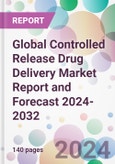Global Controlled Release Drug Delivery Market Outlook
The global controlled release drug delivery market size was valued at USD 54.8 billion in 2023, driven by rising demand for patient-centric solutions across the globe. The market size is anticipated to grow at a CAGR of 10.4 % during the forecast period of 2024-2032 to achieve a value of USD 134 billion by 2032.Controlled Release Drug Delivery: Introduction
Controlled release drug delivery is a sophisticated technology that precisely releases medication into the body at a predetermined rate, duration, and location. This approach optimizes therapeutic effectiveness, minimizes side effects, and enhances patient convenience and compliance by reducing the frequency of dosing. Commonly used in various forms such as pills, injections, or implants, controlled release systems are designed to maintain consistent drug levels in the bloodstream, ensuring a more stable and targeted treatment outcome.Key Trends in the Global Controlled Release Drug Delivery Market
There's a continuous push for advanced technologies in drug formulation and design, such as microencapsulation, nano-based delivery systems, and biodegradable polymers, aiming to achieve more precise and targeted drug release profiles.The market is increasingly focusing on enhancing patient convenience and adherence to treatment regimens. This includes the development of once-daily dosage forms and devices that are less invasive and more user-friendly.
Controlled release systems are particularly beneficial for managing chronic conditions such as diabetes, hypertension, and mental health disorders, where maintaining stable drug levels is crucial. The market is expanding to address the growing prevalence of these diseases.
The integration of controlled release technology with biologic drugs is a growing trend, aimed at extending the half-life of these high-potency drugs and reducing the frequency of dosing.
There is a growing emphasis on meeting stringent regulatory standards to ensure the safety, efficacy, and quality of controlled release products, driving innovation in manufacturing processes and quality control.
Emerging markets are increasingly adopting controlled release technologies, driven by rising healthcare expenditure, improving healthcare infrastructure, and a growing focus on enhancing the quality of life.
Global Controlled Release Drug Delivery Market Segmentation
Market Breakup by Technology
- Wurster Technique
- Coacervation
- Micro Encapsulation
- Implants
- Transdermal
- Targeted Delivery
- Others
Market Breakup by Mechanism
- Polymer Based Systems
- Micro Reservoir Partition Controlled Drug Delivery Systems
- Feedback Regulated Drug Delivery Systems
- Activation-modulated Drug Delivery Systems
- Osmotic Pressure Activated
- Hydrodynamic Pressure Activated
- Vapor Pressure Activated
- Mechanically Activated
- Magnetically Activated
- Chemically Activated
- pH Activated
- Hydrolysis Activated
- Enzyme Activated
Market Breakup by Applications
- Metered Dose Inhalers
- Injectable
- Transdermal and Ocular Patches
- Infusion Pumps
- Oral Controlled-drug Delivery Systems
- Drug Eluting Stents
Market Breakup by End User
- Hospitals
- Ambulatory Surgical Centers
- Cancer Research Institutes
- Others
Market Breakup by Region
- North America
- Europe
- Asia Pacific
- Latin America
- Middle East and Africa
Global Controlled Release Drug Delivery Market Overview
North America dominates in innovation and adoption of controlled release technologies, particularly in the U.S. and Canada. The region benefits from advanced healthcare infrastructure, substantial investments in pharmaceutical R&D, and a robust regulatory framework supporting the development of novel drug delivery systems.Europe shows a strong focus on quality healthcare and patient-centric drug development, with countries like Germany, the UK, and France leading in pharmaceutical innovation. The market is supported by stringent regulatory standards and a high emphasis on advanced drug delivery research.
Asia-Pacific is experiencing rapid growth, especially in China, India, and Japan, driven by increasing healthcare expenditure, growing pharmaceutical sectors, and rising demand for sophisticated healthcare solutions. The region is becoming a hub for pharmaceutical manufacturing and R&D, though varying regulatory landscapes can impact market dynamics.
Global Controlled Release Drug Delivery Market: Competitor Landscape
The key features of the market report include patent analysis, grants analysis, clinical trials analysis, funding and investment analysis, partnerships, and collaborations analysis by the leading key players.- Johnson & Johnson
- Novartis AG
- Pfizer Inc.
- GlaxoSmithKline plc (GSK)
- Merck & Co., Inc.
- Bristol Myers Squibb Company
- Eli Lilly and Company
- Alkermes plc.
- UCB S.A.
- Vectura Group plc.
- Coating Place, Inc.
- Skyepharma Production S.A.
- Capsugel
- Depomed, Inc.
- Aradigm Corporation
This product will be delivered within 5-7 business days.
Table of Contents
1 Preface
3 Global Controlled Release Drug Delivery Market Overview
4 Global Controlled Release Drug Delivery Market Landscape
5 Global Controlled Release Drug Delivery Market Dynamics
6 Global Controlled Release Drug Delivery Market Segmentation
7 North America Controlled Release Drug Delivery Market
8 Europe Controlled Release Drug Delivery Market
9 Asia Pacific Controlled Release Drug Delivery Market
10 Latin America Controlled Release Drug Delivery Market
11 Middle East and Africa Controlled Release Drug Delivery Market
12 Patent Analysis
13 Grants Analysis
14 Clinical Trials Analysis
15 Funding Analysis
16 Partnership and Collaborations Analysis
17 Regulatory Framework
18 Supplier Landscape
19 Global Controlled Release Drug Delivery Market - Distribution Model (Additional Insight)
21 Company Competitiveness Analysis (Additional Insight)
22 Payment Methods (Additional Insight)
Companies Mentioned
- Johnson & Johnson
- Novartis AG
- Pfizer Inc.
- GlaxoSmithKline plc (GSK)
- Merck & Co. Inc.
- Bristol Myers Squibb Compan
- Eli Lilly and Company
- Alkermes plc.
- UCB S.A.
- Vectura Group plc.
- Coating Place Inc.
- Skyepharma Production S.A
- Capsugel
- Depomed Inc.Aradigm Aradigm Corporati
Methodology

LOADING...
Table Information
| Report Attribute | Details |
|---|---|
| No. of Pages | 140 |
| Published | February 2024 |
| Forecast Period | 2024 - 2032 |
| Estimated Market Value ( USD | $ 60.5 Billion |
| Forecasted Market Value ( USD | $ 134 Billion |
| Compound Annual Growth Rate | 10.4% |
| Regions Covered | Global |
| No. of Companies Mentioned | 14 |









